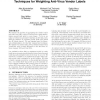Free Online Productivity Tools
i2Speak
i2Symbol
i2OCR
iTex2Img
iWeb2Print
iWeb2Shot
i2Type
iPdf2Split
iPdf2Merge
i2Bopomofo
i2Arabic
i2Style
i2Image
i2PDF
iLatex2Rtf
Sci2ools
CCS
2015
ACM
2015
ACM
Better Malware Ground Truth: Techniques for Weighting Anti-Virus Vendor Labels
We examine the problem of aggregating the results of multiple anti-virus (AV) vendors’ detectors into a single authoritative ground-truth label for every binary. To do so, we adapt a well-known generative Bayesian model that postulates the existence of a hidden ground truth upon which the AV labels depend. We use training based on Expectation Maximization for this fully unsupervised technique. We evaluate our method using 279,327 distinct binaries from VirusTotal, each of which appeared for the first time between January 2012 and June 2014. Our evaluation shows that our statistical model is consistently more accurate at predicting the future-derived ground truth than all unweighted rules of the form “k out of n” AV detections. In addition, we evaluate the scenario where partial ground truth is available for model building. We train a logistic regression predictor on the partial label information. Our results show that as few as a 100 randomly selected training instances with gr...
| Added | 17 Apr 2016 |
| Updated | 17 Apr 2016 |
| Type | Journal |
| Year | 2015 |
| Where | CCS |
| Authors | Alex Kantchelian, Michael Carl Tschantz, Sadia Afroz, Brad Miller, Vaishaal Shankar, Rekha Bachwani, Anthony D. Joseph, J. Doug Tygar |
Comments (0)

